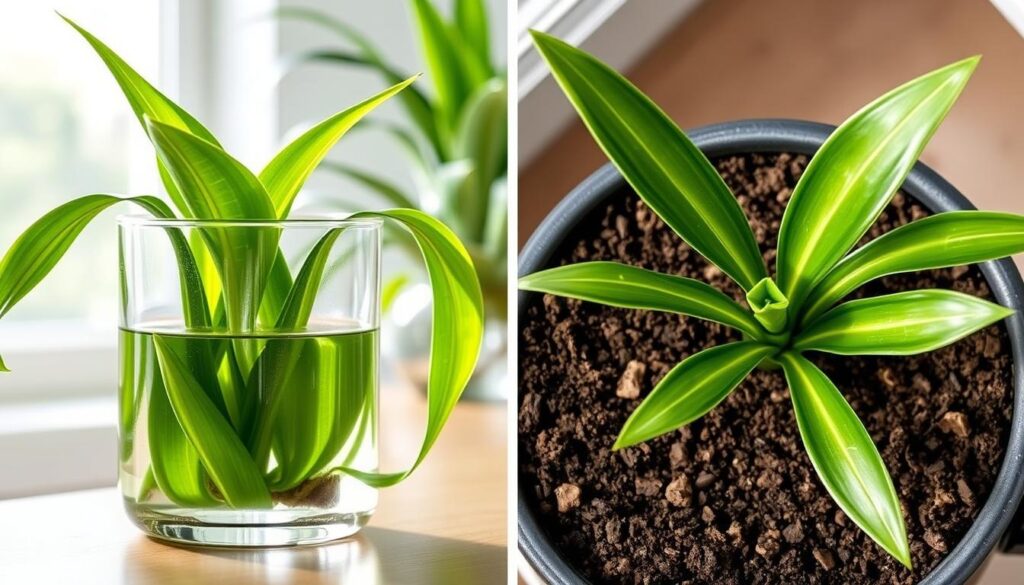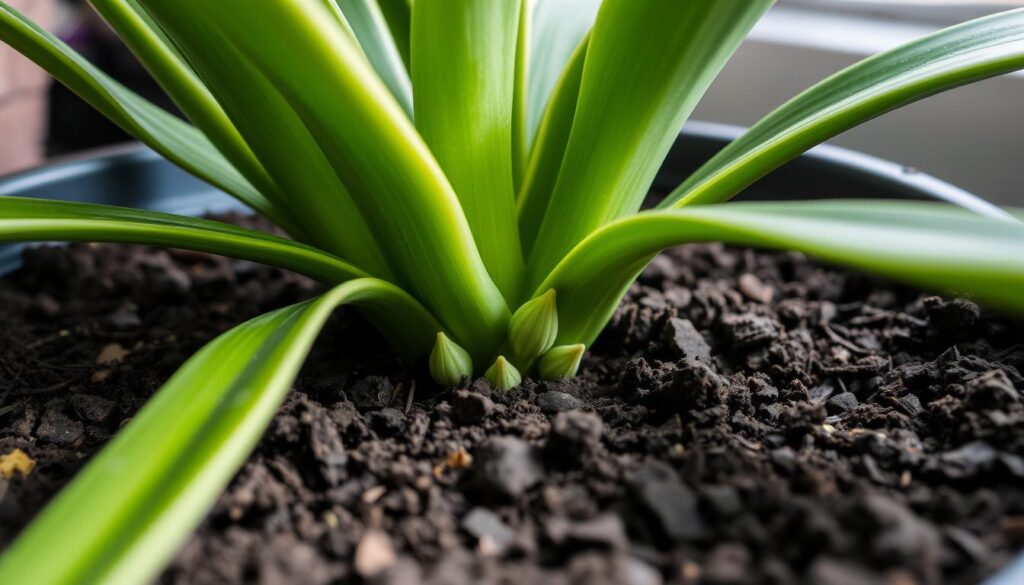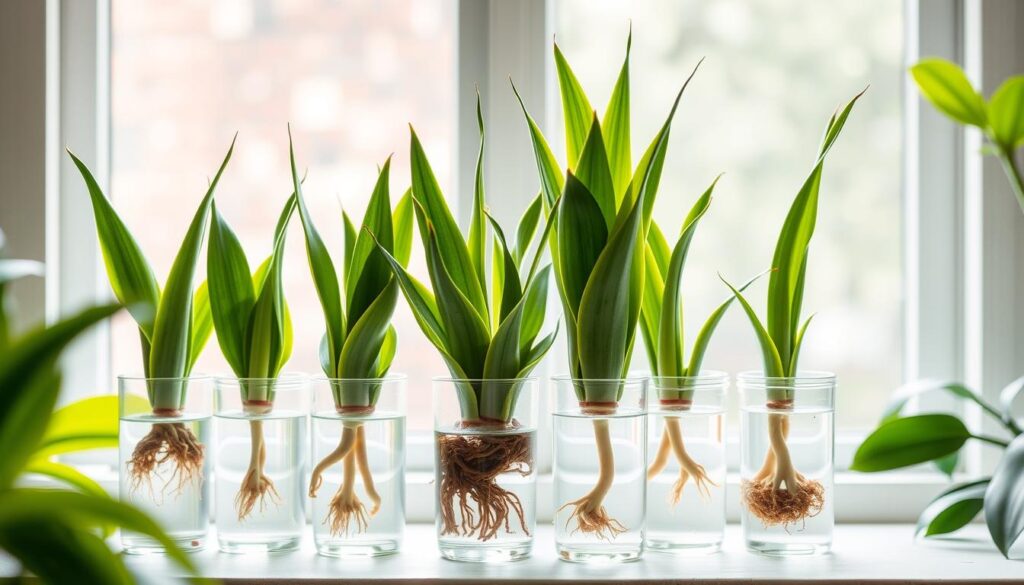I love gardening and snake plants also known as Sansevieria are my favorites. They are tough and can grow in many places. But when it is time to grow more the big question is water or soil.
In this article we will look at both ways to grow snake plants. You will learn the good and bad of each method. By the end you will know which way works best for you. So let us start this exciting journey of growing these amazing plants.
Understanding Snake Plant Propagation Basics
Propagating snake plants is a fun way to grow more of these hardy plants. It is great for both experienced gardeners and new plant lovers. Learning the basics of snake plant propagation opens up many possibilities. We will cover the different types of cuttings the best time to do it and what tools you will need.
Types of Snake Plant Cuttings
There are two main ways to propagate snake plants: leaf cuttings and rhizome cuttings. Leaf cuttings involve taking a mature leaf and splitting it into smaller pieces. Rhizome cuttings mean dividing the underground stem into smaller parts, each with a growth point.
Best Time to Propagate Snake Plants
The best time to propagate snake plants is in the spring and summer. This is when they are most active and can grow well. Don’t propagate in the winter, as the plants are dormant and may not grow as well.
Essential Tools and Materials
To propagate snake plants, you’ll need a few things. You will need sharp scissors, a potting mix, a container for water and a misting bottle. Having rooting hormone can also help your cuttings grow roots.
Now you know the basics of snake plant propagation. You are ready to start growing more of these plants. Next, we’ll look at water and soil propagation methods and how to choose the best one for you.
Water vs Soil Propagate Snake Plants: Methods Compared
Choosing between water and soil propagation for snake plants can greatly affect success. Let us look at the main differences and benefits of each method.
Water Propagation for Snake Plants
Water propagation is simpler and lets you watch roots grow closely. It’s quicker, as roots can develop faster in water. This method is easy to start with.
But, it needs constant care to keep water fresh and clean. If the water gets dirty or still, the cuttings might rot. Keeping the water right is key for success.
Soil Propagation for Snake Plants
Soil propagation gives a natural setting for roots to grow. It builds a strong root system, making the plant healthier and more resilient. It also needs less care than water propagation.
Soil propagation takes longer for roots to grow. You must prepare the soil well for good drainage and nutrients. Keeping the soil moist without causing rot is harder than in water.
| Water Propagation | Soil Propagation |
|---|---|
| Straightforward process Faster root development Easier to monitor root growth | Develops a stronger, healthier root system Requires less hands-on maintenance More natural environment for the plant |
| Requires frequent water level and quality monitoring Risk of rot if water becomes stagnant | May take slightly longer for roots to establish Requires careful soil preparation and moisture management |
Choosing between water and soil propagation depends on your preferences and plant needs. Knowing the pros and cons helps you decide and boost your chances of success.
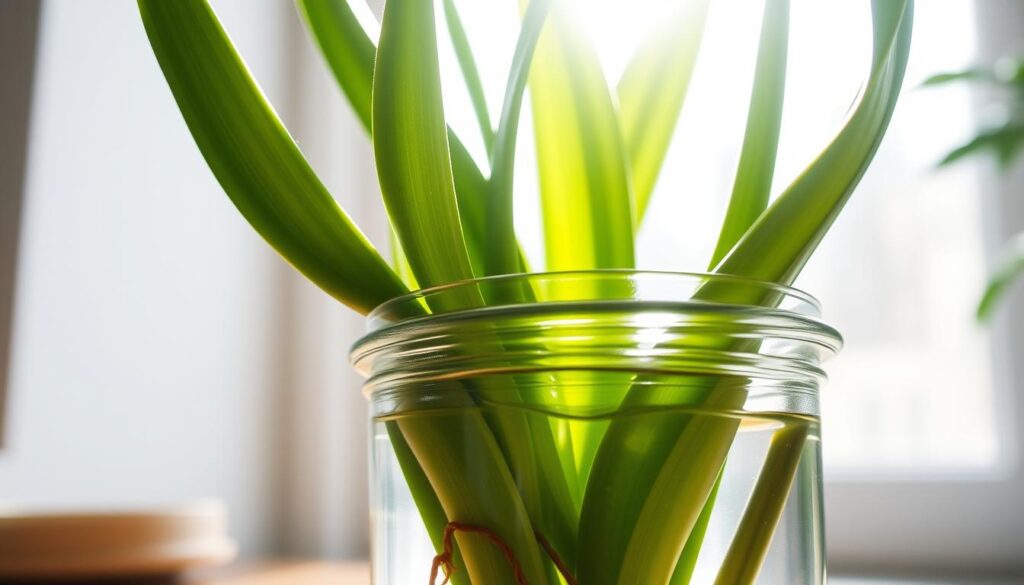
Step by Step Guide to Water Propagation
Water propagation is a great way to grow more snake plants. It’s easy to do and can help you share plants with friends. Just follow a few simple steps to root snake plant cuttings in water.
Preparing Snake Plant Cuttings for Water
Choose healthy, mature snake plant leaves for cutting. Use a sharp knife or scissors to cut them into 4-6 inch pieces. Make sure each piece has at least one leaf node.
Remove any lower leaves, leaving only the top part. This helps the cuttings grow roots from the node.
Maintaining Water Levels and Quality
Use a clean, clear glass or jar for the water. Fill it with fresh, dechlorinated water. Place the cuttings in the water, making sure the nodes are submerged but the top leaves are not.
Keep the water level the same by adding more as needed. Change the water every 7-10 days to keep it fresh.
Signs of Successful Root Development
- Look for small, white roots to appear from the nodes in a few weeks.
- As the roots grow, new green growth at the top means the plant is healthy.
- When the roots are a few inches long, it’s time to move the cuttings to soil.
By following this guide, you’ll learn how to water propagate your snake plants. It’s a rewarding process that helps your plants thrive.
Mastering Soil Propagation Techniques
Soil propagation is a great way to multiply your snake plants. It lets you grow new plants from cuttings. This method is direct and hands-on for soil propagation for snake plants. Let’s dive into the best way to multiply snake plants through this rewarding process.
Start by picking healthy, mature snake plant leaves or offshoots. Choose cuttings that are 4-6 inches long and without any damage. Make sure the cutting has a few inches of stem left. This stem is crucial for root growth.
- Get a potting mix made for succulents or cacti. This soil is perfect for your snake plant cuttings to grow well.
- Plant the cuttings in the soil, burying the stem about an inch deep. Firm the soil gently around the base to keep the cutting stable.
- Water the soil lightly. Snake plants can get root rot if the soil is too wet. So, it’s important to keep the moisture right.
- Put the potted cuttings in a warm, bright spot but not in direct sunlight. Check the soil often and water only when the top inch feels dry.
With patience and care, your snake plant cuttings will grow strong roots. This soil propagation might take weeks to months, depending on the conditions. By learning these techniques, you can easily multiply snake plants and grow a beautiful collection of them.
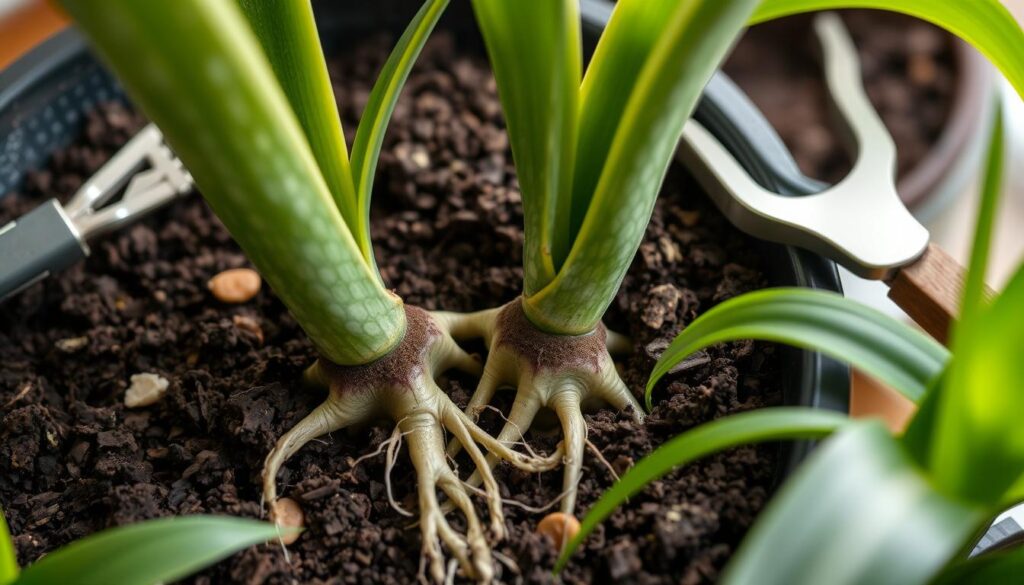
“The joy of growing your own snake plants from cuttings is unparalleled. It’s a true testament to the resilience of these plants and the satisfaction of nurturing new life.”
Common Challenges and Troubleshooting Tips
Propagating snake plants from cuttings can be rewarding but comes with challenges. Knowing common issues and how to fix them is key. This guide will help you navigate these obstacles.
Preventing Root Rot
Root rot is a big worry when growing snake plants. Keeping the soil right and ensuring good drainage is crucial. Too much water can cause the soil to become soggy, perfect for fungi and root decay.
To stop root rot, use a potting mix that drains well. Adding perlite or sand helps too. Also, check the soil moisture often and only water when it’s dry on top.
Dealing with Failed Cuttings
Not every cutting will grow. It’s okay if some don’t. Use failed cuttings as a chance to learn and do better next time.
Look at the failed cutting to see what went wrong. Maybe it was rot, pests, or not enough light or humidity. Use this info to improve your next try at growing snake plants.
Managing Environmental Factors
The environment is key for growing snake plants. Temperature, humidity, and light all matter for the cuttings’ success.
Give your cuttings bright, indirect light and keep the temperature between 65-85°F (18-29°C). They like a bit of humidity. By controlling these factors, you can help your cuttings grow well.
With patience and troubleshooting, you can overcome challenges and grow healthy snake plants. Follow these tips to grow a vibrant collection of new plants from your existing ones.
Aftercare and Transplanting Guidelines
Once your snake plant cuttings have strong roots, it’s time for aftercare and transplanting. Proper handling at this stage is key to your plants’ success.
Transitioning from Water to Soil
If you’ve been growing your snake plants in water, it’s time to move them to soil. This step needs care to avoid harming the roots. Here is how to do it.
- Prepare a well-draining potting mix for snake plants.
- Gently remove the rooted cutting from the water, being careful not to disturb the roots.
- Plant the cutting in the prepared soil, making sure the roots are fully covered but the leaf and stem remain above the soil line.
- Water the soil thoroughly, but avoid overwatering.
- Place the newly transplanted snake plant in a spot with bright, indirect light.
Repotting Soil-Propagated Plants
If you’ve grown your snake plants in soil, they might need a bigger pot as they grow. Here’s how to repot them:
- Choose a slightly larger pot with good drainage capabilities.
- Gently remove the plant from its current pot, being careful not to damage the roots.
- Place the plant in the new pot and fill in the gaps with fresh, well-draining potting mix.
- Water the soil thoroughly, but avoid overwatering.
- Position the repotted snake plant in a spot with bright, indirect light.
Whether you propagated in water or soil, make sure your plants get the right water, light, and nutrients. This will help them thrive and grow more.
| Factors | Water Propagation | Soil Propagation |
|---|---|---|
| Rooting Time | Faster root development | Slower root development |
| Transplanting | Requires careful transition to soil | Easier to transplant directly to soil |
| Maintenance | Requires regular water changes | Requires well-draining soil and proper watering |
| Success Rate | Generally higher success rate | May have a slightly lower success rate |
The choice between water and soil propagation depends on your preference and your plants’ needs. By following these guidelines, you can ensure your plants’ health and increase snake plant population in your garden.
“Proper aftercare is crucial for the success of your newly propagated snake plants. Take the time to ensure a smooth transition, and you’ll be rewarded with healthy, thriving plants that will enhance your space for years to come.”
FAQ
What are the benefits of water propagation for snake plants?
Water propagation is great for snake plants because it’s easy and looks nice. The roots grow in water making it easy to see if they are doing well. This way, I can make sure the cuttings are ready to move to soil.
How do I prepare snake plant cuttings for soil propagation?
To prepare cuttings for soil, I take clean, healthy stems. I let them dry for a few days before planting. This step helps prevent rot and promotes root growth.
What are some signs that my snake plant cuttings have successfully rooted?
Signs of successful rooting include new leaves, a firm stem, and white, healthy roots. For water propagation, I look for roots at the cuttings base. For soil I check by gently pulling on the cutting.
How can I prevent root rot when propagating snake plants?
To prevent root rot, I use clean tools and choose healthy cuttings. I avoid too much water in the soil. For water, I change it often and watch for decay signs.
In soil I use a mix that drains fast and only water when the top inch is dry.
What’s the best way to transplant my newly propagated snake plant cuttings?
When transplanting I am careful not to hurt the new roots. For water-propagated cuttings, I remove them gently and plant in well-draining soil. For soil-propagated cuttings, I water the soil well before transplanting to reduce shock.
